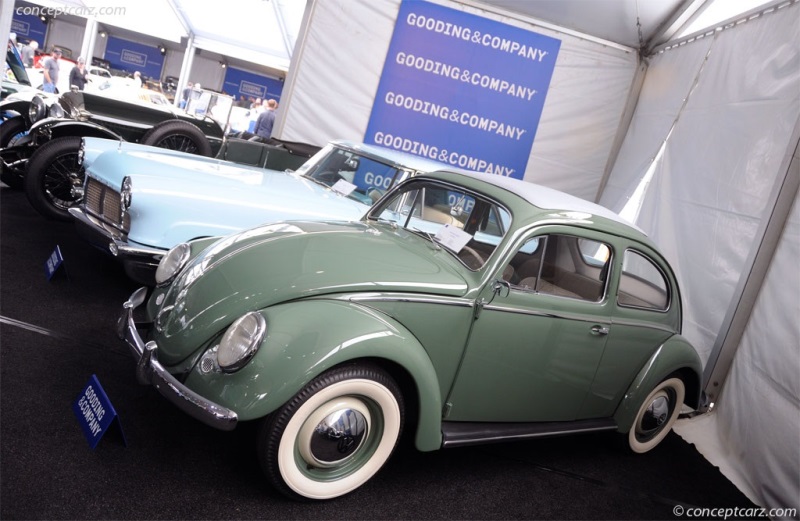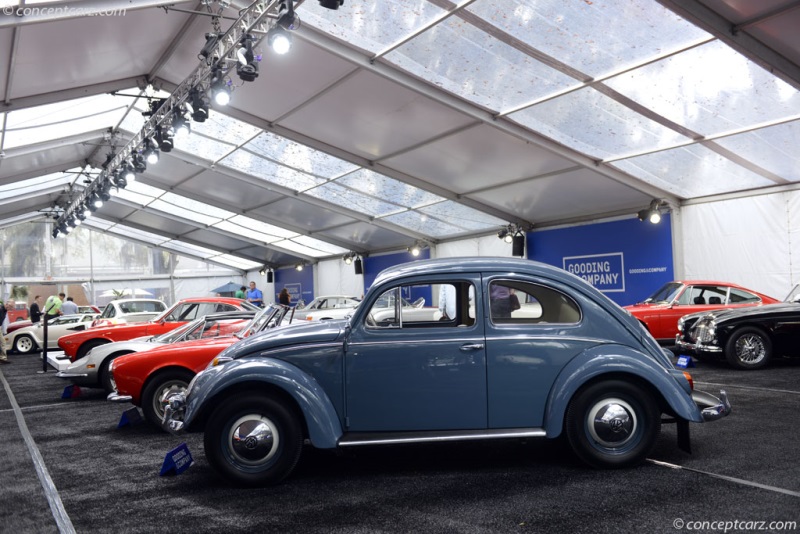


Sedan
Chassis #: 1933828
The Volkswagen Type 1 was designed by a team that was led by Ferdinand Porsche in the 1930s as an economical automobile that could mobilize Germany. The project was funded and overseen by the government. Between 1938 and 2003, over 21 million examples have been produced making them the longest-running and most-produced vehicle in history. This Volkswagen Beetle is from a year that saw many updates to its iconic design, including a new rectangular rear window and a larger windscreen. For 1958, Volkswagen produced 451,526 examples which was nearly 70,000 more than the prior year. This car is finished in blue with gray and blue interior. Currently, the odometer shows just 11,000 miles which are believed to be original.
By Daniel Vaughan | May 2015


Sunroof Sedan
Chassis #: 1805386
This Volkswagen Beetle was completed on January 22, 1958 and delivered to Cologne, Germany. It is finished in the color (L240) Agave Green, over (K304) Green/Gray Leatherette. It has a fabric ragtop, trafficators, an outside mirror, and a rare Loria FM ashtray radio. Power is from a flat 4-cylinder engine which displaces 1192cc and is fitted with a single Solex carburetor. There is a four-speed manual transaxle and four-wheel hydraulic Drum brakes.
By Daniel Vaughan | Oct 2016
The Beetle is perhaps the best-selling car of all time. Truly, a recognizable shape that has stood the test of time. The vehicle is still being produced in Mexico, continuing the long-time running record.Adolf Hitler was searching for a people's car that was capable of transporting three children and two adults at speeds of sixty miles-per-hour. The car was to be inexpensive, costing the same as a motorcycle. Ferdinand Porsche was commissioned to produce such a vehicle. There are many theories as to where the designs originated from. Some believe Hitler designed the vehicle. Some theorize that it was Joseph Ganz's 1920 design that was the true inspiration for the Beetle design. Porsche had created designs for the Mercedes-Benz 170H, which played into the design of the Beetle.
The Volkswagen Beetle first came on the scene in 1947, but they were known by a different name. KdF, short for Kraft durch Freude meaning 'power by joy', was designated for these small, gas-friendly vehicles. In English, the name Beetle was used. In German, they were known as Kafer, and in French, they were called Coccinelle. These little bundles of joy featured mechanical drum brakes and a gearbox void of synchromesh. In 1949 the Volkswagen logo was placed on the rims. The engine was expanded to 1131 cc and was capable of producing 25 horsepower. The models that were produced after October of 1949 could be started without a 'starting crank'.Two convertible options were offered by Volkswagen in 1949. The two-seater design, designated 14A, was penned by Josef Hebmuller. The four-seater Type 15 version was designed and produced by Karmann of Osnabruck. The four-seater was vastly more popular and stayed in production for 30 years.The 14A was stylish and attractive, with the major shortcoming being a fire that destroyed the factory where they were being produced. The two-seaters featured a rear deck nearly identical to the front hood. The strength of the car, lost by removing the roof, was amplified by a stronger windshield frame and dual Z-section girders located under the floor. In 1953, the last of the Hebmuller rolled off the assembly line, after only 696 examples were produced.In a time when practicality ruled over style, the four-seater cabriolet was king. The Karmann company had a long history of designing and building cars. In business since 1901, was familiar with assembly line production, benefits and features of different types of metals, and the styles of multiple markets.
During the 1950's the Beetle saw exterior and interior improvements. 1951 saw the addition of arm-rests which were discontinued just a few months later. In 1952, 2nd-4th gears became synchronized. The dashboard was redesigned with a glove compartment. The rear of the Beetle was updated in 1953, receiving a new single oval pane window in place of its original split rear window design. In 1955, the bumper was improved and electrical direction-indicators were installed. A second tail-pipe was added. The front seats became wider and could be moved to three different seat-back adjustable positions.In 1956, the tires became tubeless. Near the end of '56, side view mirrors became standard on all Beetle models.In 1957 the front window was increased by 17 percent while the rear window received a 95 percent increase. A new dashboard, rear view mirror, radio, and a speaker appeared. The turn signals would now turn-off automatically. Up to this point, a roller pedal had been used to initiate acceleration. This was the year that the gas pedal replaced the roller pedal. In 1958, ivory disc wheels were offered.In 1960, an engine capable of producing 34 horsepower was offered. The speedometer was increased from 74 mph to 87 mph. A windshield-wiper washer system became available. The front directional light was changed from white to amber.A gas gauge was added in July of 1961. In 1963, the seats were changed from wool upholstery to synthetic. The VW emblem located on the hubcap was no longer painted. The safety of the vehicle was once-again enhanced with enlarged directional lights.There were minor changes in 1964. The windows did, however, become larger.In 1965, the front axle was improved. The ongoing saga of incremental improvements received another chapter - A defroster vent was added to the center of the dashboard.The Beetle continued to be sold in the United States until 1978 with the convertible version sold until early 1980. Sales continued in Europe until 1985. Developing countries, such as Mexico, have been developing the Beetle since 1964 and the vehicles have remained in production since that time.
By Daniel Vaughan | Jan 2019
Inspiration for the Beetle had been drawn from the Tatra vehicles, mainly the T97, that had been designed by Hans Ledwinka. Due to the similarities, Tatra launched a lawsuit that never really materialized due to Germany invading Czechoslovakia. The lawsuit was later re-opened after World War II and Volkswagen was forced to pay Tatra 3,000,000 Deutsche Marks. This left Volkswagen with little money for the development of new Beetle models.
The mechanical, cable-driven brakes were replaced with hydraulic brakes in 1950.
By Daniel Vaughan | Jan 2019
Similarly Sized Vehicles
from 1958
Similarly Priced Vehicles
Austin-Healey Sprite ($1,790-$1,790)
Morris Minor ($1,550-$1,650)
Fiat 600 Multipla ($1,590-$1,590)
Ford Custom 300 Series ($1,980-$2,260)
Fiat 500 ($1,095-$1,760)
AMC Rambler Six ($2,050-$2,620)
Chevrolet Del Ray Series ($2,000-$2,470)
Ford F-100 ($1,505-$2,165)
DKW Auto Union 1000 ($1,675-$1,675)
Volkswagen Transporter ($1,955-$2,740)
Average Auction Sale: $16,783
Morris Minor ($1,550-$1,650)
Fiat 600 Multipla ($1,590-$1,590)
Ford Custom 300 Series ($1,980-$2,260)
Fiat 500 ($1,095-$1,760)
AMC Rambler Six ($2,050-$2,620)
Chevrolet Del Ray Series ($2,000-$2,470)
Ford F-100 ($1,505-$2,165)
DKW Auto Union 1000 ($1,675-$1,675)
Volkswagen Transporter ($1,955-$2,740)
Average Auction Sale: $16,783
Volkswagen Monthly Sales Volume
March 2023
67,853
1958 Volkswagen Beetle Vehicle Profiles
Recent Vehicle Additions
Performance and Specification Comparison
Price Comparison
$1,955 - $2,740
$2,450 - $2,730
Beetle Specification Comparison by Year
Year
Production
Wheelbase
Engine
Prices
Related Automotive News

Auctions America Continues Successful 2013 Season with its Annual Fall Carlisle Sale
Auctions America rounds out its 2013 auction season in Carlisle, Pennsylvania, October 3-4
Two-day Fall Carlisle sale, held in conjunction with the Carlisle Events Collector Car Swap Meet %26 Corral, features a diverse roster of 300 classics, exot...

Auctions America Readies for Highly Anticipated Spring Carlisle Collector Car Weekend
Auctions America returns to Carlisle, Pennsylvania for its annual Spring Carlisle sale, April 25-26
Two-day sale lifts the gavel on a diverse roster of approximately 300 quality collector cars
Notable highlights include a rare 1959 Chevrolet C...

VICARI AUCTION COMPANY OFFERS RARE '62 & '63 Z06 CORVETTES AT 2013 CRUISIN' NOCONA
In a recent rare find, two classic Chevrolet Corvettes (one 62 and one 63) - stored for decades-are being made available by the Vicari Auction Company. Both vehicles will cross the block during 2013 Cruisin Nocona, a north Texas collector car auction...

Barrett-Jackson Flavors Its January Scottsdale Auction With NASCAR Treats
RACING HERITAGE, HIGH PERFORMANCE ARE RECIPES FOR CAR-COLLECTING FEAST
SPEED™ SET FOR 39 HOURS of LIVE COVERAGE STARTING JAN. 15
The great Henry Ford once said, Auto racing began five minutes after the second car was built.
...

TOPLINE COLLECTORS PLACE SPOTLIGHT on SPEED'S BARRETT-JACKSON BROADCAST FROM SCOTTSDALE
TOPLINE COLLECTORS PLACE SPOTLIGHT on SPEEDS BARRETT-JACKSON BROADCAST FROM SCOTTSDALE
LOST SHELBY DUAL PROTOTYPE, HAGERTY GIVEAWAY %26 SALON COLLECTION HIGHLIGHT 39 HOURS OF LIVE COVERAGE
The 42nd annual Barrett-Jackson Scottsdale (Ar...
















